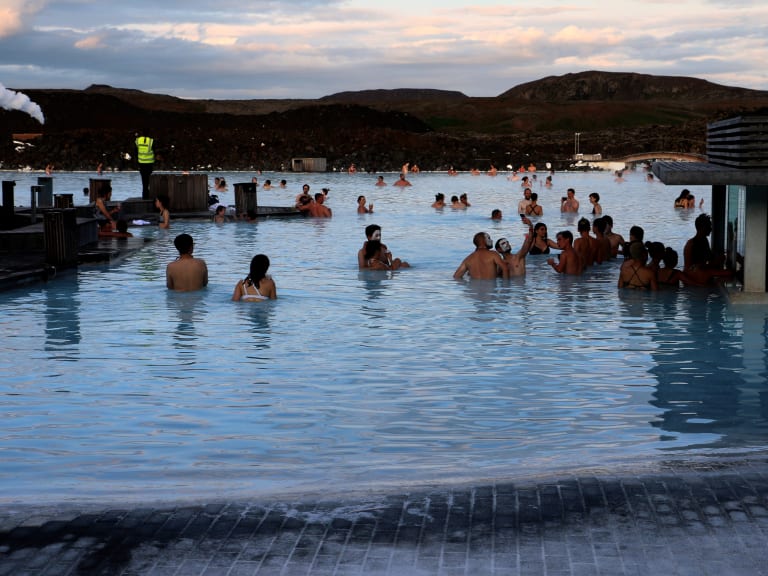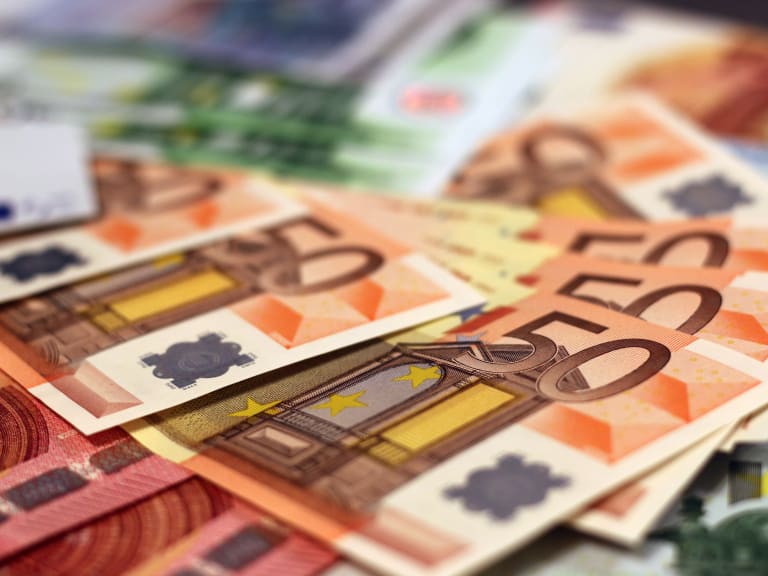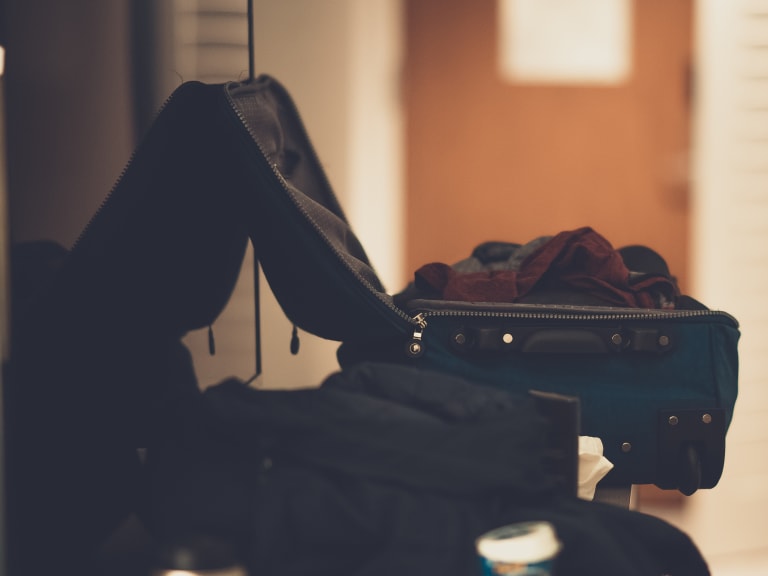More about: Things to do in Reykjavik in Summer
I'd say summer is the best time of year to visit Reykjavík and Iceland in general, and that's because it's a really cold country with very harsh winters, so if there's a great time to be a tourist in these parts, it's summer.
I'll leave you with a list of things I like to see and do in Reykjavík and Iceland during this time of year, from exciting festivals to whale-watching trips, and even one of the simplest but most fun things to do - partake in the 'world's biggest bread soup'.
1. Hiking the summer-only hiking trails

When it's the summer season, locals in Reykjavík and all over Iceland take advantage of the short period of warm temperatures to visit as many places as possible and do outdoor activities whenever they can.
One of the best ways to take advantage of the warm weather is by hiking on the designated hiking trails. During the winter many of the trails in and around Reykjavík are closed due to excessive snow and ice. In summer these places open up to offer locals and visitors access to the most inhospitable and beautiful parts of the country.
In the same vein as hiking, another similar activity you can do in summer is to sign up for a bus tour of Reykjavík or even take a road trip into the highlands.
Like the hiking trails, the mountain roads freeze over and get covered with snow. In summer they reopen to welcome tourists.
2. Tour the city of Reykjavík on foot from early morning hours

As you know, in Reykjavík and in Iceland as a whole, summer time is really valued. That's why one of the activities I especially recommend you to do in summer is to walk the streets of the city all day long.
Reykjavík is not too big and not too crowded, so walking the streets, or most of them, in one day won't be too difficult.
I recommend you take one of the tours of Reykjavík to get to know in detail the history behind this city that once lived from fishing and hides a Viking past.
If you don't want to take a guided tour of the city, it is also an option to get up very early in the morning and walk around the streets. Among the highlights I recommend you to visit are the church and the Harpa concert centre among other interesting buildings.
3. Participate in the world's biggest bread soup

Although not a literal term, it is one of the best attractions you can enjoy in Reykjavík during the summer. It's the world's largest bread soup, which is the melting of Lake Tjornin in the centre of Iceland's capital.
Skating on the ice, playing hockey or even walking on it can be some of the most fun things to do in Reykjavik in winter, but when summer arrives, a great diversity of birds arrive at Lake Tjornin- it is said that around a hundred different species may inhabit the lake.
With temperatures a little warmer than usual, during the summer these birds make the lake their home, and the city's inhabitants flock to the site every day to feed them, especially with bread, hence the term that has become familiar. It is an especially ideal activity if you are a nature lover and a bird lover in particular.
4. Enjoy music without limits at Innipúkinn Festival

If there's one thing locals like to do when summer comes, it's enjoy good music, which is why the Innipúkinn Festival is one of the most recommended for this season.
It's a three-day festival of non-stop music, where tourists and locals have the opportunity to warm up their bodies by singing, dancing and enjoying concerts in the city of Reykjavik.
This festival takes place on the first weekend of August and is an experience that I highly recommend you experience on your trip to the city during the summer. It is a festival especially for those who prefer to stay at home instead of heading to the countryside for other traditional festivals.
Interesting details
- Price: Tickets to this festival are usually available at the box office on the day you go. You have the option of buying a three-day pass or a day pass. Prices can be found at the entrance to the event.
- How to get there: The festival takes place in the city centre for three nights on the first weekend in August.
- Time: It lasts all night, taking advantage of the sunlight that never fully sets during the summer.
5. Take a trip to the Silfra Fault from Reykjavik

Despite its plethora of festivals, Reykjavík remains an unassuming capital compared to its European peers, which is why you shouldn't waste your summer time in Iceland by staying in the capital alone.
There are plenty of excursions and getaways from Reykjavík that you can do to make the most of summer in this stunning place, and one of them is to take a guided tour from Reykjavík to the Silfra fault.
This is one of the most impressive places in the world and the experience of being there is indescribable. It is also a World Heritage Site, as it is the only place visible above sea level where you can see the dividing plate between the European and American continents.
The best time to visit this place is definitely in summer, when you can make the most of the snorkelling experiences in Reykjavik, because you can easily see the marine life that abounds here, as well as explore the three sections into which the plate is divided. You 'll be especially impressed by the transparency of the water.
Interesting details
- Price: You can book this experience with snorkelling included, at an approximate price of 165 euros per person.
- Duration: It lasts approximately 5 and a half hours, remembering that during the summer, the days are considerably longer in Iceland.
- Means of transport: The tour includes pick-up from the hotel to where you will board the boat and back. On land the transport is a minivan for a few people and equipped with air-conditioning. Once you are on the boat, the boat will take you to the snorkelling spot.
- Advantages of this adventure: It is an incredible experience to see the fissure that connects both continents of the earth. The activity is suitable for children from 12 years old. You will be accompanied by a guide who will explain everything you need to know about the sea. The experience is completely personalised, as a maximum of six people per group is allowed.
- Disadvantages of this experience: You need to know how to swim to enjoy the moment. Participants must be in excellent physical condition to undergo the activity. You need to bring a packed lunch and a change of warm clothes for after the dive. This experience is not recommended for pregnant women or people suffering from any special physical condition such as heart conditions and the like.
6. Embark on a whale watching cruise in the midnight sun

If there's one thing you can do in Reykjavík and Iceland in general all summer long, it's to go whale watching for species that you can only see at this time of year.
Whale watching is definitely one of the best boat and cruise tours in Iceland and one of the most enjoyable experiences during your stay in the city.
To participate in this activity, I recommend you book one of the whale watching tours in Reykjavik. Whales come to Iceland during the summer season to feed, so it's a great time to see them up close.
There are tours that depart from Reykjavík to the open sea to show you this natural phenomenon in the middle of the night. The most interesting thing about doing this tour is that the sun never fully sets, so during the midnight open sea tour, you'll be able to see the sun on the horizon.
Interesting details
- Price: This Icelandic midnight adventure can cost around 85 euros per person.
- Duration: You will need around 3 hours to make the journey to the open sea.
- Distance from Reykjavík: The departure point is located in the city of Reykjavík, from there to the whale watching site depends on how far the boat goes offshore.
- Advantages of this adventure: It is a good activity to do as a couple and to be with few people. You can watch multimedia material about Iceland's marine life as you sail from Reykjavík harbour to the whale watching area. You can take prams and it is also wheelchair accessible. Winter trousers are available on request.
- Disadvantages of this experience: Although it is summer, temperatures in Iceland are really low, so you have to wear really warm clothes to be able to go on this summer tour, because the nights are usually even colder.
7. Attend the Midsummer or Midnight Sun Festival

Icelanders love the arrival of summer so much that they have their own festival to celebrate the event: the Midsummer celebration is an event that occurs every year on the first day of summer.
Although it is an event that is celebrated all over Iceland, with people from its most remote villages taking to the streets to flood the atmosphere with music and festivities, the real Midsummer festival takes place in the capital, Reykjavík.
The city is filled with music at the big festival, which brings together Icelandic artists and sometimes artists from other parts of the world, who come to celebrate the beginning of the summer season with the locals.
The most interesting thing about this celebration is that it begins when the midnight sun sets, i.e. the sun sets in a position where it can fill the whole country with light at 00:00 hours. This marks the beginning of summer.
Interesting details
- Price: Free of charge.
- How to get there: The biggest festival takes place in the centre of the capital.
- Time: Celebrated on the first day of summer, which usually takes place in the third week of June.
8. Trader's Day Festival

Along with the celebration of the summer solstice, there is one tradition you can't miss if you go to Reykjavík and that is the celebration of Merchant's Day. This is perhaps one of the most famous celebrations in Reykjavík and Iceland as a whole, although over time it has taken a back seat among the locals.
Whether its popularity is on the rise or decline, it's an experience I highly recommend you experience in Iceland in the summer. It's a collective excursion into the countryside near the country's capital to celebrate the arrival of the summer solstice and the fact that the days will now be longer than usual. Locals gather here to enjoy the sun and the arrival of summer.
Interesting details
- Price: Free of charge.
- How to get there: Drive from Reykjavík along the summer roads to the fields.
- Timetable: There is no timetable for this celebration, you can go to the fields near the capital and camp. However, the celebration is on the first Monday in August.
9. Go and eat fish on the big fish day

As an island, Iceland has a deep-rooted fishing culture and its traditions are built on fishing. That's why one of the most important summer celebrations in Reykjavík is the one that pays tribute to fish and how it has managed to be present in all aspects of Icelandic culture.
During this fish day, locals and visitors alike gather in the city to cook seafood and other seafood and prepare traditional Icelandic dishes.
These dishes are offered free of charge to the public and the day is enlivened by live music and fireworks. It's definitely a summer activity that I would include among the best food tours in and around Reykjavik.
Details of interest
- Price: Free.
- How to get there: Take a route along one of the summer roads to the town of Akureyri if you want a long but pleasant journey. If you want to get to Akureyri faster, your best option is to take a flight. You could go by bus but it will take you about six hours to get there.
- Opening hours: The free all-you-can-eat buffet lasts from 11:00 to 17:00.
10. Learn more about the Icelanders during the culture night

Although it is not a summer tradition, it is a spectacle that takes place during this time of year. Specifically, 18 August is the date chosen to celebrate Icelandic culture.
This is similar to celebrations held in other countries to commemorate national independence day. In the case of Iceland's capital, this is the commemoration of the proclamation of Reykjavík as a municipality.
It is easy to catch the festive atmosphere on the streets during Iceland's culture night, which is celebrated not only in Reykjavík but also in nearby towns.
The capital's museums and art galleries stay open until the early hours of the morning and one of the most important events is the Reykjavík Marathon, which attracts more than 3500 participants annually.
Here's what summer temperatures are like in Reykjavík

Although it is summer weather, the truth is that Reykjavík, and Iceland in general, is a very cold place all year round, and this is because it is a very northerly country, so temperatures tend to drop very low at certain times of the year.
Summer temperatures, however, rarely exceed 14ºC during the day, while the night remains cooler, even though the sun does not go down completely. It is clear that in these temperatures, locals take advantage of the summer weather to enjoy themselves outdoors.
Summer tourist numbers in Reykjavík

As you can imagine, the higher temperatures, the summer thaw and the cultural activity that engulfs this city and the whole country during the summer are excuses enough for Reykjavík to fill up with tourists from all over the world.
A very important tip is that, day after day, when you wake up to discover new destinations, put laziness aside and do it even earlier, with the intention of arriving early to the attractions you want to visit and avoid long queues everywhere.
These are the average summer prices in Reykjavík

High season equals high prices, and this is no different in Reykjavík. If you have been convinced so far that summer is probably the best time to visit Reykjavík, you should know that one of the disadvantages of visiting during this time of the year is the high cost of excursions, hotels, restaurants and other tourist services.
A good way to save money and get better prices for visiting Reykjavík in the summer is to make reservations for hotels, restaurants and excursions well in advance of when you plan your trip, so that you can secure your place in the tours you want to take, the hotels you want to stay in and the restaurants you want to visit.
Here's what to pack for your summer trip to Reykjavík

As you know, Reykjavík and Iceland as a whole is a country that is far enough north to have cold temperatures all year round. So in this country, summer does not equal sunglasses, swimming costumes and sunscreen.
I recommend packing plenty of warm clothes, thermal trousers to help keep your legs warm, thick socks, closed shoes, winter jackets, among other things that can help you maintain a warm body temperature during such a hostile climate.




